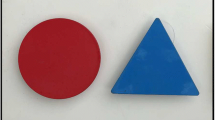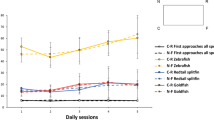Abstract
Fish move in a three-dimensional environment in which it is important to discriminate between stimuli varying in colour, size, and shape. It is also advantageous to be able to recognize the same structures or individuals when presented from different angles, such as back to front or front to side. This study assessed visual discrimination abilities of rotated three-dimensional objects in eight individuals of Pseudotropheus sp. using various plastic animal models. All models were displayed in two choice experiments. After successful training, fish were presented in a range of transfer tests with objects rotated in the same plane and in space by 45° and 90° to the side or to the front. In one experiment, models were additionally rotated by 180°, i.e., shown back to front. Fish showed quick associative learning and with only one exception successfully solved and finished all experimental tasks. These results provide first evidence for form constancy in this species and in fish in general. Furthermore, Pseudotropheus seemed to be able to categorize stimuli; a range of turtle and frog models were recognized independently of colour and minor shape variations. Form constancy and categorization abilities may be important for behaviours such as foraging, recognition of predators, and conspecifics as well as for orienting within habitats or territories.






Similar content being viewed by others
References
Altbäcker V, Csanyi V (1990) The role of eyespots in predator recognition and antipredatory behaviour of the Paradise Fish, Macropodus opercularis L. Ethology 85:51–57
Altevogt R (1951) Vergleichend-psychologische Untersuchungen an Hühnerrassen unterschiedlicher Körpergrößen. Z Tierphysiol 8:75–109
Altevogt R (1953) Untersuchungen über das optische Auflösungsvermögen der Amsel, Turdus merula. LJF Ornithol 94:220–251
Bisazza A, Brown C (2011) Lateralization of Cognitive Functions in Fish. In: Brown C, Laland K, Krause J (eds) Fish cognition and behavior, 2nd edn. Blackwell Publishing Ltd, Oxford, pp 298–324
Bisazza A, Rogers LJ, Vollortigara G (1998) The origins of cerebral asymmetry: a review of evidence of behavioural and brain lateralization in fishes, reptiles and amphibians. Neuro Behav Rev 22:411–426
Broglio C, Gómez A, Durán E et al (2005) Hallmarks of a common forebrain vertebrate plan: specialized pallial areas for spatial, temporal and emotional memory in actinopterygian fish. Brain Res Bul 66:277–281. doi:10.1016/j.brainresbull.2005.03.021
Brown C, Laland K, Krause J (2011) Fish cognition and behavior, 2nd edn. Blackwell Publishing Ltd, Oxford
Burmann B (1998) Visuell Diskriminierungsleistung bei einem Wanderu (Macaca silenus). Rheinische Friedrich—Wilhelms Universität Bonn
Burmann B, Dehnhardt G, Mauck B (2005) Visual information processing in the lion-tailed macaque (Macaca silenus): mental rotation or rotational invariance? Brain Behav Evol 65:168–176. doi:10.1159/000083626
Cantalupo C, Bisazza A, Vallortigara G (1995) Lateralization of predator-evasion response in a teleost fish (Girardinus falcatus). Neuropsychologia 33:1637–1646
Carleton K, Harosi F, Kocher T (2000) Visual pigments of African cichlid fishes: evidence for ultraviolet vision microspectrophotometry and DNA sequences. Vis Res 40:879–890
Colwill RM, Raymond MP, Ferreira L, Escudero H (2005) Visual discrimination learning in zebrafish (Danio rerio). Behav Proc 70:19–31. doi:10.1016/j.beproc.2005.03.001
Csanyi V (1985) Ethological analysis of predator avoidanceby the paradise fish (Macropodus opercularis), I Recognition and learning of predators. Behaviour 92:227–240
Csanyi V (1986) Ethological analysis of predator avoidanceby the paradise fish (Macropodus opercularis) II. Key stimuli in avoidance learning. Anim Learn Behav 14:101–109
D’Amato M, Colombo M (1985) Auditory matching-to-sample in monkeys (Cebus apella). Anim Learn Behav 13:375–382
Darmaillacq AS, Dickel L, Rahmani N, Shashar N (2011) Do reef fish, Variola louti and Scarus niger, perform a modal completion? Evidence from a field study. J Comp Psychol 125:273–277
Delius J, Hollard V (1995) Grientation invariant pattern recognition by pigeons (Columba liva) and humans (Homo sapiens). J Comp Physiol A 109:278–290
Dobberfuhl A (2005) Visual acuity, environmental complexity, and social organization in African cichlid fishes. Behav Neurosci 119:1648–1655
Douglas RH, Eva J, Guttridge N (1988) Size constancy in goldfish (Carassius auratus). Behav Brain Res 30:37–42
Fernand R (1985) Eye movements in the African cichlid fish, Haplochromis burtoni. J Comp Physiol A 156:199–208
Fernand R, Liebman P (1980) Visual receptor pigments in the African cichlid fish, Haplochromis burtoni. Vis Res 20:857–864
Fine ML, McElroy D, Rafi J, King CB, Loesser KE, Newton S (1996) Lateralization of pectoral stridulation sound production in the channel catfish. Physiol Behav 60:753–757
Frech B (2009) Verhaltensphysiologische Analyse der visuellen Wahrnehmung räumlicher Tiefe beim, PhD Thesis, Johannes Gutenberg-Universität Mainz, pp 134
Frech B, Vogtsberger M, Neumeyer C (2012) Visual discrimination of objects differing in spatial depth by goldfish. J Comp Physiol 198:53–60
Gierszewski S, Bleckmann H, Schluessel V (2013) Cognitive abilities in Malawi Cichlids (Pseudotropheus sp.): matching-to-sample and image/mirror-image discriminations. PLoS ONE 8:e57363. doi:10.1371/journal.pone.0057363
Graeber RC, Ebbesson SO (1972) Visual discrimination learning in normal and tectal-ablated nurse sharks (Ginglymostoma cirratum). Comp Biochem Physiol 42:131–139
Guthrie DM (1986) Role of Vision in Fish Behaviour. The behaviour of teleost fishes, In, pp 75–113
Hager H (1938) Untersuchungen über das optische Differenzierungsvermögen der Fische. Zeitschrift für vergleichende Physiologie 26:282–302
Henrichfreise G, Dücker G (1983) Vergleichende Untersuchungen zum Problem des serialen Umkehrlernens bei Fischen (Carassius auratus L., Cyprinus carpio L., Salmo gairdneri Richardson). Zoologischer Anzeiger 211:197–213
Herter K (1929) Dressurversuche an Fischen. Report aus dem Zoologischen Institut der Universität Berlin
Herter K (1930) Weitere Dressurversuche an Fischen. Report aus dem Zoologischen Institut der Universität Berlin
Herter K (1953) Die Fischdressuren und ihre sinnesphysiologischen Grundlagen. p 326
Hobson E (1966) Visual orientation and feeding in seals and sea lions. Nature 210:326–327
Hollard V, Delius J (1982) Rotational invariance in visual pattern recognition by pigeons and humans. Science 218:804–806
Horio G (1938) Die Farb-und Formdressur an Karpfen. Jap J med Sci Trans III Biophys 4:395–402
Huber R, Van Staaden M, Kaufmann LS, Liem KF (1997) Microhabitat use, trophic patterns, and the evolution of brain structure in African cichlids. Brain Behav Evol 50:167–182
Ingle D (1965) Interocular transfer in goldfish: colour easier than pattern. Science 149:1000–1002
Karplus I, Algom D (1981) Visual cues for predator face recognition by reef fishes. Z Tierphysiol 55:343–364
Karplus I, Goren M, Algom D (1982) A preliminary experimental analysis of predator face recognition by Chromis caeruleus (Pisces, Pomacentridae). Z Tierphysiol 58:53–65
Kirsch JA, Kabanova A, Güntürkün O (2008) Grouping of artificial objects in pigeons: an inquiry into the cognitive architecture of an avian mind. Brain Res Bull 75:485–490
Lee SA, Vallortigara G, Ruga V, Sovrano VA (2012) Independent effects of geometry and landmark in a spontaneous reorientation task: a study of two species of fish. Anim Cog 15:861–870
Mackintosh J, Sutherland N (1963) Visual discrimination by the goldfish: the orientation of rectangles. Anim Behav 11:135–141
Mark R (1966) The tectal commissure and interocular transfer of pattern discrimination in cichlid fish. Exp Neurol 16:215–225
Mauck B, Dehnhardt G (1997) Mental rotation in a California Sea Lion (Zalophus Californianus). J Exp Biol 200:1309–1316
Meesters A (1940) Über die organisation des Gesichtsfeldes der Fische. Z Tierpsychol 4:84–149
Miklosi A, Andrew RJ (1999) Right eye use associated with decision to bite in zebrafish. Behav Brain Res 105:199–205
Rowland W (1999) Studying visual cues in fish behaviour: a review of ethological techniques. Environ Biol Fish 56:285–305
Salas C, Broglio C, Durán E et al (2006) Neurophysiology of learning and memory in teleost fish. Zebrafish 3:157–171
Saxena A (1960) Lernkapazität, Gedächtnis und Transpositionsvermögen bei Forellen. Zoologisches Jahrbuch, Abteilung Allgemeine Zoologie 69:63–94
Schaller A (1926) Sinnesphysiologische und Psychologische Untersuchungen an Wasserkäfern und Fischen. Zeitschrift für vergleichende Physiologie 4:371–464
Schluessel V, Bleckmann H (2005) Spatial memory and orientation strategies in the elasmobranch Potamotrygon motoro. J Comp Physiol A 191:695–706
Schluessel V, Fricke G, Bleckmann H (2012) Visual discrimination and object categorization in the cichlid Pseudotropheus sp. Anim Cog 15:525–537. doi:10.1007/s10071-012-0480-3
Schuster S, Rossel S, Schmidtmann A et al (2004) Archer fish learn to compensate for complex optical distortions to determine the absolute size of their aerial prey. Curr Biol 14:1565–1568. doi:10.1016/j
Shepard R, Metzler J (1971) Mental rotation of three-dimensional objects. Science 171:701–703
Shumway C (2008) Habitat complexity, brain, and behaviour. Brain Behav Evol 72:123–134. doi:10.1159/000151472
Siebeck U, Wallis G, Litherland L (2008) Colour vision in coral reef fish. J Exp Biol 211:354–360
Siebeck U, Litherland L, Wallis G (2009) Shape learning and discrimination in reef fish. J Exp Biol 212:2113–2119. doi:10.1242/jeb.028936
Sovrano VA, Bisazza A (2008) Recognition of partly occluded objects by fish. Anim Cog 11:161–166. doi:10.1007/s10071-007-0100-9
Sovrano VA, Bisazza A (2009) Perception of subjective contours in fish. Perception 38:579–590. doi:10.1068/p6121
Sovrano VA, Bisazza A, Vallortigara G (2003) Modularity as a fish views it: conjoining geometric and non-geometric information for spatial reorientation. J Exp Psych Anim Behav Proc 29:199–210
Sovrano VA, Bisazza A, Vallortigara G (2007) How fish do geometry in large and in small spaces. Anim Cogn 10:47–54
Srinivasan M (2010) Honey bees as a model for vision, perception, and cognition. Annu Rev Entomol 55:267–284
Sutherland N (1964) Visual discrimination of animals. Br Med Bull 20:54–59
Truppa V, Sovrano VA, Spinozzi G, Bisazza A (2010) Processing of visual hierarchical stimuli by fish (Xenotoca eiseni). Behav Brain Res 207:51–60
Vallortigara G (2004) Visual cognition and representation in birds and primates. In: Rogers LJ, Kaplan G (eds) Vertebrate Comparative Cognition: Are Primates Superior to Non-Primates?. Kluwer Academic/Plenum Publishers, New York, pp 57–94
von der Emde G, Behr K, Bouton B et al (2010) 3-Dimensional scene perception during active electrolocation in a weakly electric pulse fish. Front Behav Neurosci 4:26. doi:10.3389/fnbeh.2010.00026
von Frisch K (1913) Weitere Untersuchungen über den Farbensinn der Fische. Zool Jahrb Allg Zool Physiol 34:43–68
von Frisch K (1914) Der Farbensinn und Formensinn der Biene. Zool Jb Physiol 35:1–182
Wohlschläger A (1995) Determinations of mental rotation speed, the relation between mental rotation and rotatory object manipulation. Ruhr- Universität Bochum
Wunder W (1934) Gattenwahlversuche bei Stichling und Bitterling. Deutschen Zoologischen Gesellschaft 36:152–158
Wyzisk K (2005) Experimente zur Form- und Größenwahrnehmung beim Goldfisch (Carassius auratus) unter Verwendung von Scheinkonturen und Größentäuschungen. Johannes-Gutenberg-Universität Mainz
Wyzisk K, Neumeyer C (2007) Perception of illusionary surfaces and contours in goldfish. Vis Neurosci 24:291–298
Acknowledgments
We would like to thank Slawa Braun for help with care taking of animals and maintenance of aquaria and J. Mogdans for helpful comments on the manuscript. The research reported herein was performed under the guidelines established by the current German animal protection law. Most of the experimental work presented herein was conducted by H. Strauch as part of her Diploma-Thesis at the University of Bonn.
Author information
Authors and Affiliations
Corresponding author
Rights and permissions
About this article
Cite this article
Schluessel, V., Kraniotakes, H. & Bleckmann, H. Visual discrimination of rotated 3D objects in Malawi cichlids (Pseudotropheus sp.): a first indication for form constancy in fishes. Anim Cogn 17, 359–371 (2014). https://doi.org/10.1007/s10071-013-0667-2
Received:
Revised:
Accepted:
Published:
Issue Date:
DOI: https://doi.org/10.1007/s10071-013-0667-2




